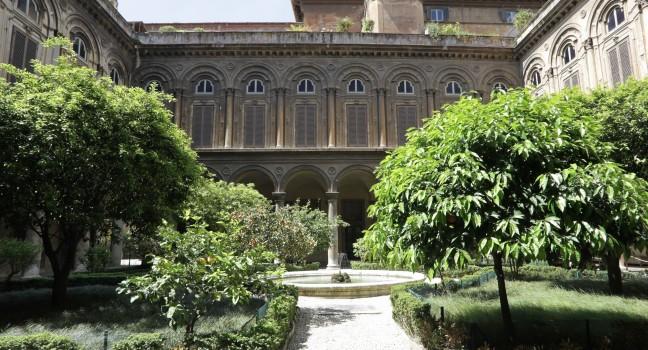The site of Pompeii, the petrified memorial to Vesuvius's eruption in AD 79, is the largest, most accessible, and probably most famous excavation anywhere. A busy commercial center with a population of 10,000–20,000, ancient Pompeii covered about 170 acres on the seaward end of the fertile Sarno Plain. Today it's choked with both the dust of 25 centuries and more than 3 million visitors every year; only by escaping the hordes and lingering along its silent streets can you truly fall under the site's spell. On a quiet backstreet, all you need is a little imagination to picture life in this ancient town.
Come in the late afternoon, when the site is nearly deserted, and you will understand the true pleasure of visiting Pompeii.
If entering via Porta Marina, the revamped (2021) Antiquarium traces the history of Pompeii from the Samnite era (4th century BC) until AD 79. Among the artifacts displayed are the House of the Golden Bracelet frescoes, the triclinium (dining room) of the House of Menander, and the recently created casts of the Civita Giuliana villa victims.
Get your bearings at the Foro (Forum), which served as Pompeii's cultural, political, commercial, and religious hub. You can still see some of the two stories of colonnades that used to line two sides of the square. Like the ancient Greek agora in Athens, the Forum was a busy shopping area, complete with public officials to apply proper standards of weights and measures. Fronted by an elegant portico on the eastern side of the forum is the Macellum, a covered meat and fish market dating to the 2nd century BC. The nearby Terme del Foro (Forum Baths) offered a relaxing respite. It had underground furnaces, the heat from which circulated beneath the floor, rose through flues in the walls, and escaped through chimneys: temperature could be set for cold, lukewarm, or hot. On the southwestern corner is the Basilica, the city's law court and the economic center. These oblong halls were the model for early Christian churches, which had a nave (central aisle) and two side aisles separated by rows of columns.
Several homes were captured in various states by the eruption of Vesuvius, each representing a different slice of Pompeiian life. The Casa del Poeta Tragico (House of the Tragic Poet) is a typical middle-class residence. On the floor is a mosaic of a chained dog and the inscription cave canem ("Beware of the dog"). The Casa dei Vettii (House of the Vettii) is the best example of a wealthy merchant's home.
There's no more magnificently memorable evidence of Pompeii's devotion to the pleasures of the flesh than the frescoes on view at the Villa dei Misteri (Villa of the Mysteries), a palatial abode built at the far northwestern fringe of Pompeii. Unearthed in 1909 this villa had many rooms, all adorned with frescoes—the finest of which are in the triclinium. Painted in the most glowing Pompeiian red, the panels relate the saga of a young bride and her initiation into the mysteries of the cult of Dionysus, who was a god imported to Italy from Greece and then given the Latin name of Bacchus.
Pompeii's other major edifice is the Anfiteatro (Amphitheater), once the ultimate entertainment venue for locals. It provided a range of experiences, though these essentially involved gladiators rather than wild animals. Built in about 70 BC, the oval structure was divided into three seating areas. There were two main entrances—at the north and south ends—and a narrow passage on the west called the Porta Libitinensis, through which the dead were most probably dragged out.
To get the most out of Pompeii, rent an audio guide (€8 for one, €13 for two; you'll need to leave an ID card) at Porta Marina, and opt for one of the three itineraries (two hours, four hours, or six hours). If hiring a guide, make sure the guide is registered for an English tour and standing inside the gate; agree beforehand on the length of the tour and the price. You can find a knowledgeable and qualified guide at www.vesuviusvspompeii.com or www.contexttravel.com.
A few words about closures: which excavations are open or closed when you arrive might seem a caprice of the gods adorning many of the buildings' walls, but the actual determining factors include availability of staff, geological uncertainty, and restoration. Many excavations are closed long-term for restoration. The Casa del Fauno and Casa del Menandro are usually always open, however, as is the central core of the city, a visit requiring two or more hours itself. In 2019, La Schola Armaturarum—the so-called Casa dei Gladiatori (House of the Gladiators)—was restored after water damage had caused its roof to collapse in 2010, an event that made world headlines and highlighted the need to better protect Pompeii's treasures. It's now open on certain days April through October, an emblem of revitalized preservation efforts and improved management. Check the website for the latest news and exhibitions, and the updated list of visitable buildings at pompeiisites.org/en/houses. If you're lodging in the town of Pompei, note that there's a convenient entrance to the ruins near the amphitheater off Piazza Santa Immacolata.




